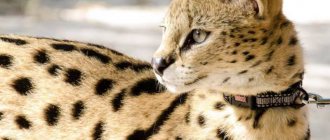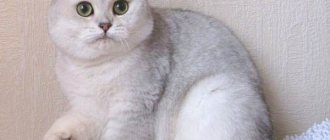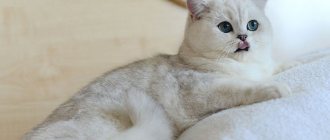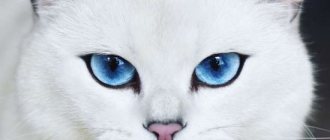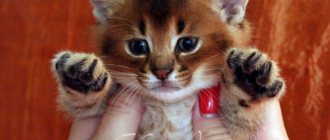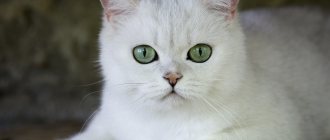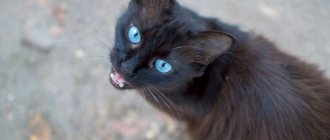Contrary to their name, Himalayan cats are not related to the mountains of the same name and were developed in the United States by crossing Siamese and Persian cats. In Europe, the cat is known as the Persian color-point. Himalayan (as well as Siamese, acromelanistic or pointing) is a characteristic color in which the protruding parts (muzzle, ears, paws and tail) are darker than the color of the whole body.
Although not all felinological associations recognize this breed, considering it only a variety of the Persian cat, it is in demand among professional breeders and hobbyists.
History of the origin of the Himalayan cat
Throughout the 20th century, attempts to breed a long-haired cat with a colorpoint color were made repeatedly by breeders from the USA, Canada, Great Britain and Sweden. So, in the 1930s, it was possible to cross a black Persian male with a Siamese female, but as a result, short-haired kittens were born that inherited the color of their father. Only in the 1950s, the experiments of the Canadian B. Boret, and in parallel with him the American M. Goforth, made it possible to select a breed with the body type and coat of a Persian cat and the color of a Siamese.
In 1957, the Himalayan cat was recognized by the international Cat Fanciers' Association (CFA). The breed got its name in honor of the Himalayan rabbit, which has a similar color.
However, in 1984, due to the similarity of exteriors, the Himalayan breed was merged with the Persian, receiving the status of a “subbreed” or “division” (color group). TICA (The International Cat Association) holds the same opinion, considering Himalayan cats in the same group with Persian and exotic shorthairs.
Other felinological associations (NCFA, AACE, ACFA, CCA, CFF, UFO) classify the Himalayan as a separate species with its own breed standard.
Development and age-related changes
Kittens are born light colored. Shaded marks appear in the second or third year of life. At a young age, representatives of this breed are active and playful. As cats get older, they become more passive.
Kittens up to six months old are fed 4 times a day. Six-month olds are transferred to three meals a day. When the pet reaches one and a half years old, the frequency of feeding is reduced to twice a day.
Description of the breed
The Himalayan cat is a large, long-haired breed with short, muscular legs. What gives her a special charm are her large round eyes of an inexpressibly beautiful blue color, sharply contrasting with the dark “mask” on her wide muzzle.
Standard
- Body: stocky, equally developed in the shoulders and rump, level back. The legs are short with highly developed muscles, straight. The male weighs about 4 - 6 kg, females 3 - 4.5 kg. A very short neck flows smoothly into the body.
- Head: wide skull, powerful jaws, correct bite. The shape of the head is round, smoothed. Cheeks are full. The profile is short. The forehead, nose and chin are located on the same line.
- Ears: small with rounded tips, set at a considerable distance from each other.
- Eyes: round and large, widely set, bright blue.
- Tail: Proportional to body length, covered with long hair.
- Coat: long, thick, shiny. The frill on the neck turns into a train between the legs. A large number of colors.
Colors
Reference! The characteristic color appears only in the second or third year of a cat’s life.
The most common ones include:
- seal point is a cream, sometimes reaching light brown, color of the body and neck with dark brown markings on the prominent parts of the body.
- flame point or red point - protruding parts are fiery red
More rare colors:
- cake point (tortoiseshell) – the walrus color of the markings is interspersed with cream and red spots.
Important! Usually only females are tortoiseshells; a cat of this color is rare and cannot have offspring.
- blue point – bluish-white color of the whole body with darker “tan marks”. This color is valued the more highly, the deeper the shade of blue the cat's eyes have.
- cream point - “tan marks” of a delicate cream color.
- chocolate point – chocolate markings on an ivory background. This color was especially popular in the 90s and early 2000s.
More valued than others:
- lilac point or frost point - the color of the markings is bluish-pinkish (lilac).
- tabby point or lynx point (marbled or brindle) - the fur on the body of such cats is very light, and the markings have clearly visible stripes of any color (walrus, blue-gray, milk chocolate). The mask has an M-shaped pattern on the forehead, plain ears with a light spot on the outside.
Health
Himalayans have relatively strong immunity. Among the diseases characteristic of the breed are polycystic kidney disease. Also, due to the “flattened” muzzle, pets may be bothered by increased lacrimation.
Life expectancy is on average 12-14 years, but there are also long-livers. The health and longevity of blue-eyed fluffies directly depends on the conditions of detention, care, and proper feeding.
Health and susceptibility to disease
Although the Himalayans are an artificially bred breed, they have relatively good heredity and live about 13-14 years. True, these cats still have certain health problems.
Himalayans are prone to the following diseases:
- polycystic kidney disease;
- cataract;
- obesity;
- dermatitis;
- sinus inflammation;
- skin asthenia.
Photos of Himalayan cat
Photos of beautiful representatives of the Himalayan breed. The second photo shows a Himalayan cat with a pointed muzzle.
Attitude towards the pet
Cats of this breed require special attention.
- The owner will have to carve out several hours a week for hygiene procedures.
- Their absence will negatively affect the condition of the pet.
- Cats are loving. They love affection and tenderness.
- Despite their calm attitude towards loneliness, they become strongly attached to people.
- Shows of kindness and love are expected to be reciprocated.
This breed is suitable for equally calm and phlegmatic people. Patience is one of the essential qualities of a future owner.
The nature and behavior of the Himalayan cat breed make them suitable companions for families with children and other animals.
Character of the Himalayans
Being a cross between Persian and Siamese cats, the Himalayan has combined the features of its “ancestors” in its character, having inherited curiosity from the Siamese, and a good disposition and laziness from the Persians.
Himalayans are excellent companions for both adults and children. Their affectionateness and love of love is manifested in their special affection for their owner. Such cats can treat strangers with wariness, but not with aggression, and after getting to know each other more closely, they will shower them with their attention.
The Siamese gave the breed a love of games. The Himalayan loves toys and paper balls.
An interesting feature of the Himalayan cat is that they meow little, so they will not annoy you with loud demands. An important advantage is that the animals easily get along with other pets.
Nutrition
The breed is quite capricious and has a lot of hereditary diseases.
Therefore, the cat’s diet must be balanced and correct.
You should not treat your pet with food from the owner's table and overfeed it too much.
Possible problems
The Himalayan cat has long, thick hair, so people with a tendency to allergies are directly contraindicated to have one. The joke “In a house where a cat lives, everything is a cat” is more relevant than ever in the case of the Himalayans. Therefore, “clean people” are also unlikely to like the animal.
Such a pet is not suitable for those who want active games with a cat or often move from place to place, on business trips and travel.
Vaccinations and antiparasitic treatment
To prevent viral and infectious diseases, the Himalayan cat is systematically vaccinated against panleukopenia, rhinotracheitis and calcivirosis. The first vaccination for a kitten of this breed is given at 7-8 weeks.
After 28 days, the Himalayan is vaccinated against the same diseases and against rabies. Subsequently, the cat is vaccinated once a year.
To prevent the development of diseases carried by fleas and worms, the Himalayan is periodically given antiparasitic treatment.
Anthelmintic drugs are given to a representative of the breed twice a year with mandatory repetition after 10-14 days. The dosage is calculated strictly according to the weight of the Himalayan.
The animal is treated against fleas using special drops or shampoos. And if a Himalayan cat has access to the street, it is additionally protected with an anti-parasitic collar.
Care
Wool
Especially careful care is required for the luxurious wool of the Himalayan. It consists of combing your pet daily, preferably in 3 steps: first with a wide-tooth comb to remove large tangles, then with a more frequent comb and, finally, with a special brush to remove dead hairs. The most problematic areas are the neck, paws and the area under the tail, where the fur rolls up the fastest.
The issue of water procedures causes a lot of controversy. Some argue that the coat of a Himalayan cat needs to be washed with shampoo almost weekly, while others consider bathing once every six months to be sufficient. It is wise to take a closer look at your pet and bathe it as needed, taking into account its lifestyle and living conditions.
Nutrition
With an excessive and unbalanced diet, Himalayans are prone to gaining excess weight. It is recommended to choose dry and wet food from the premium and super-premium segments, intended for cats with long hair: they promote better digestion and removal of hairballs from the stomach. In addition, it is advisable to use malt paste to remove trichobezoars.
From natural products, low-fat protein foods (chicken, beef, turkey) and complex carbohydrates (various types of cereals, sprouted wheat) are welcome.
Caring for ears, eyes and other body parts
The breed is characterized by increased tearfulness, so hygiene procedures should include daily washing with a damp cotton pad. The direction of movement is from the eye to the nose, otherwise inflammation cannot be avoided.
When caring for your pet's ears, remove excess wax with a cotton swab. It is possible to use special ear drops.
It is necessary to trim the claws 1-2 times a month, but the procedure can be performed less frequently if the cat is accustomed to the scratching post.
Walking the pet, living conditions in the apartment
The Himalayan cat is a “domestic” animal in the full sense of the word. Ideal for apartments or private houses. However, too small and cramped spaces will put pressure on the pet’s psyche and can cause neuroses and even aggression. For a good mood and well-being, a cat needs space and the opportunity to explore all corners of the home.
Due to the structure of the nose, problems with the animal’s thermoregulation are possible, so it is necessary to maintain an optimal temperature at home (20-22°C) and shade the room on a hot, sunny day.
If the owner is determined to walk the fluffy beauty outside, he must be prepared for more frequent bathing, the use of anthelmintic drugs and mandatory vaccinations.
Diseases
Himalayan cats adopted many features and health problems from Persians. Snoring and grunting at night is not a reason for panic, but just a feature of the structure of the respiratory system. But don’t allow stressful situations!
If the cat becomes very frightened or nervous, it will have problems breathing - it becomes noisy and difficult. Don't get colds! Even small drafts cause bronchitis and pulmonary pathologies in the Himalayans.
The most common ailments are:
- Baldness (it is caused by severe shocks and experiences: the animal begins to comb or bite its body, tearing out shreds of fur);
- Skin asthenia (the skin becomes thinner and sags, folds form on it, which easily tear);
- Obesity (due to a sedentary lifestyle and an incorrectly composed diet);
- Cataract (hereditary disease);
- Inflammation in the sinuses (pathogenic microbes accumulate in the nose);
- Polycystic kidney disease (cysts grow around the kidneys).
Cats are susceptible to parasites and easily pick up viruses, so give deworming medications on time and get all the necessary vaccinations. “Himalayans” tolerate castration and sterilization calmly: their character remains just as calm and friendly.
Expert opinion
Dusheba Vera Ivanovna
In 2010, she graduated from the Moscow State Academy of Veterinary Medicine named after K.I. Scriabin with honors, specializing in veterinary medicine. I regularly attend veterinary conferences, congresses, and webinars.
The following symptoms indicate an illness: refusal of food or water; weight loss; changes in behavior (unusual lethargy or aggression); repeated vomiting or diarrhea; presence of blood in the urine; swelling of the eyelids; purulent discharge from the eyes; cataract. If you notice anything from the list, take your pet to the vet immediately!
Breed card
| Characteristics of a cat | Notes | |
| General information | The cat looks like a Persian breed | Not everyone recognizes Himalayan cats as a separate breed. |
| Character | Calm, balanced and friendly | Fairly playful, but not hyperactive |
| Appearance | The body type and length of the coat came from the Persians, and the point color from the Siamese. | Thick, light coat with dark spots on the face, ears, tail and paws The final color is formed by 2 years |
| Behavior at home | Periods of calm and sleep alternate with playfulness. Loves the house and does not strive for walks outside the apartment | Great pet |
| Care | Daily brushing is required | Not suitable for people who are not ready to deal with a lot of wool in the apartment or have allergies |
| Health problems | Blocked tear ducts due to flat face Polycystic kidney disease | Individuals with a pointed muzzle are less likely to have this problem. |
Castration and sterilization of a Himalayan pet
if you do not want kittens, then it is better to castrate/sterilize your pet
If a cat is not expected to produce offspring, it is recommended to sterilize it. In cases where a cat goes into regular heat but is not bred, she may get sick. This will affect the female health of the animal. Diseases can be very different (even cancer). Cats are sterilized to prevent them from marking their territory. Males secrete strong-smelling substances that end up in urine on the floor, walls and sometimes things.
Castration is a surgical procedure that involves the complete removal of organs that are responsible for the reproduction of animals. Thus, during castration, the ovaries are removed along with the uterus in cats, or just the ovaries alone (in cats, the testicles, respectively). Sterilization of cats is limited to ligation of the fallopian tubes, and for cats this is fraught with ligation of the seminal ducts. This operation can be performed under local anesthesia (this method is optimal).
You can spay/neuter your pet when its internal organs are fully formed (a year and a half). The timing may vary depending on the development of the animal, so you may want to consult your veterinarian. In some cases (for example, if there are medical indications), the operation is performed earlier. This is usually practiced in nurseries. If the breeder believes that the kitten should not produce offspring in the future, then it will be castrated. However, this can lead to health problems. Due to early castration/sterilization, the reproductive system may not develop correctly.
Video: caring for your pet after surgery
How to choose a Himalayan kitten
The choice of a Himalayan kitten is complicated by the fact that the point color is finally formed only by the 2-3rd year of the animal’s life. Until 3 months of age, it is difficult to discern even a hint of a mask and a “scorched” effect on the tail and paws in the white fluffy ball. To avoid getting into trouble, you should pay attention to the parents of the future pet and carefully study the documents confirming the pedigree.
When buying a kitten, also take into account:
- physical form and appearance of the cat,
- conditions for keeping animals in the nursery,
- age of pets.
The price of the issue depends on many factors: color, gender, reputation of the nursery, “title status” of the parents. A kitten that can perform at exhibitions cannot cost less than 10,000 rubles.
The purchase is completed by the issuance of documents by the seller. Package includes:
- contract of sale;
- kitten card (exchanged for pedigree);
- veterinary passport, which indicates the vaccines administered and the dates of deworming.
Table: pros and cons of the breed
| Characteristic | pros | Minuses |
| Appearance | a very fluffy cat with a beautiful point color and expressive blue eyes | Not everyone likes the exotic flattened face |
| Character | kind cat, affectionate, sociable, balanced (impossible to provoke aggression) | phlegmatic about everything new |
| Kittens | easy to care for, unpretentious | it's hard to find purebred kittens |
| Nutrition | Himalayan cats eat almost everything and are not picky | you need to maintain a balance of vitamins and microelements |
| Appearance care | are not afraid of water when bathing, love to be brushed | there may be tangles, watery eyes |
| Health | strong health, no genetic predisposition to diseases | sometimes they snore, there may be congenital defects in appearance (number of fingers, etc.) |
| Breeding and reproduction | childbirth is the same as in cats of other breeds | it is difficult to find a partner with stable traits and pedigree |
| Owner reviews | there are many who are satisfied with the character and habits of their pet | there are those who are not happy with the hassle of taking care of their appearance |
| Kitten price | you can find a kitten for 10 thousand rubles (or cheaper) | in foreign nurseries, a kitten costs from $500 |
Breeding
For successful breeding work with the Himalayan cat, high quality stud cats and cats are required. Not only the external, exhibition characteristics of the animal are very important, but also a strong pedigree. This means that the quality can be traced over several generations and the necessary characteristics are well fixed in the genotype. It is from such animals that good kittens will naturally be born. Often a recessive gene is responsible for the desired color, so inbreeding is common in Himalayan breeding, i.e. mating within the same bloodline.
Cats can be bred once they reach sexual maturity (approximately 8–9 months). The number of kittens in the litter is from 3 to 6.
The greatest variety of colors in litters comes from Himalayan cats with tortoiseshell (tortie-point) and blue-cream-point colors. So, kittens can be born from a torty point female and seal point males: seal point, blue point, flame point (males), cream point (males), tortie point (females) and blue cream point (cats).
Today, the number of nurseries involved in breeding Himalayan cats is growing. Here are examples of some of them, found as a result of simple surfing on the Internet:
- Fleur de Mireille – Moscow.
- Luber - Moscow.
- Dikanta - St. Petersburg.
- COLOROLLA – Severodvinsk.
Colors
The coat of Himalayan cats is very pleasant to the touch: it is so thick, soft and silky that you want to stroke them without stopping. The decorative part is strong, despite the fact that it is very thin.
By the age of three, Himalayan cats finally develop their color. At the same time, the shades may be different, but the overall picture will always be the same: color point, repeating the pattern on the Siamese coat.
The Himalayans have a gene in their genome that once gave their ancestors, Siamese cats, their typical color. The point is this: the color of the fur, skin and iris of all mammals is formed under the influence of melanins. These pigments with an irregular structure are formed under the influence of UV rays during the oxidation of the cellular protein tyrosinase. In the case of Himalayan cats, tyrosanase is produced, but becomes extremely sensitive to changes in body temperature. That is why the “prominent” parts - paws, tail, ears and muzzle - have a rich, bright shade, and the main coat color is lighter.
Types of colors:
- Color point is a classic Siamese color: the dark parts of the body are painted a uniform dark color, the contrast is clearly visible;
- Lynx (tabby point) - the animals’ eyes seem to be lined with a dark pencil, there is a pattern on the forehead in the form of the letter “M”, dark areas in the form of stripes, the tail and ears are light on the inside.
Additional color can be lilac, blue, cream, red-red, brown, dark chocolate. The rarest colors are: choclit point (chocolate), cream point (cream), blue cream point (bluish-cream), the most expensive is lilac point (purple or lilac). There is also a so-called brindle color, but since it has only now become of interest to breeders, cats with this color can literally be counted on one hand.
The bright spot on the face should have clear boundaries and not “creep” onto the chest, neck and back.
Interesting facts about the breed
- The gene responsible for pointing (Siamese, Himalayan) color is recessive in relation to the dominant gene for non-Siamese color. This means that both parents must pass on the gene in order for the kitten to have its external manifestation.
- The blue color of the eyes of Himalayans is due to the low level of melanin in the cells of the iris.
- Persians are the only cats in the world that have a flattened skull, like pug bulldogs. This feature was passed on to the Himalayan and exotic shorthaired Persians. However, there is a variety of Himalayan with a more traditional - pointed muzzle.
The Himalayan cat is ideal for those who are looking for a loyal friend, curled up comfortably on the owner's lap. The lucky owners of these cats will not have to worry about the fact that the pet will not get along well with other animals, meow loudly and be a nuisance in every possible way. The only caveat is the hassle of caring for the luxurious wool of the Himalayans.
Education and training
Despite their generally docile nature, Himalayan cats are in no hurry to join the educational process. For this reason, basic etiquette standards need to be instilled in an animal from a very early age - an adult Siamese who has managed to master bad habits, unfortunately, cannot be re-educated. After the kitten has been socialized and accustomed to its new home, immediately begin developing its toilet habits. The tray should be located in the most calm and quiet place and in no case next to the food bowl.
The little Himalayan should be placed on the tray immediately after sleep and active play. To make sure your baby understands that the toilet belongs only to him, it is recommended to put a piece of cloth in the litter that you used to wipe up the puddle left by your pet. At the same time, wean your animal from the habit of sharpening its claws on furniture, but first buy a scratching post. If after this the kitten encroaches on the upholstery, sprinkle water on it when you catch it sabotaging, and then send it back to the scratching post.
Are you used to leaving aromatic delicacies on the table? Get ready for your cat to taste them! Himalayans, of course, are passive companions, but they cannot resist a tasty treat left unattended. You need to wean your ward off jumping on the table immediately and unconditionally. Firstly, do not leave meat products on the kitchen surface so as not to tempt your furry. Secondly, try to make sure that this piece of furniture evokes unpleasant associations in the animal. For example, treat it with products that have a strong menthol or citrus scent, which cats hate. You can also place strips of tape on the table, sticky side up, to “catch” the prankster with them.
Teaching a Himalayan cat funny tricks is difficult and essentially unnecessary, but if you decide to play the role of a great trainer, stock up on deli meats. Make allowances for the fact that cats are not dogs; they will not strain solely out of a desire to please you. An important nuance is to clearly convey to the animal what is expected of it. For example, if you want to teach a cat to sit on command, then you first need to demonstrate a treat, and then gently persuade the fluffy to the required position, rewarding it with a delicacy for doing so. Some owners use catnip as a training stimulus. This is the easiest path that experts do not recommend taking.
It is also useful to slightly modify the method with tasty rewards by adding a clicker to the treat. Click the device while the command is being executed, and then, if the task is completed, treat the cat with a treat. Soon the fluffy will understand that the sound of the clicker is followed by encouragement, and will fulfill the requirements more readily. By the way, if you notice that the cat is sincerely resisting your commands and is trying to leave, you should not try to suppress his will. Exercise only when the cat is ready to study and no more than once a day - in a 15-minute lesson, the breed exhausts its internal resource and needs a long rest.
Feeding
Proper and rational nutrition is a necessity and the main rule of protection against possible diseases, but it should be remembered that cats of this breed are prone to obesity and, even more so, their diet must be balanced. Dry or wet food containing the appropriate amount of required vitamins and nutrients, most suitable for the Himalayan breed.
The beauty, appearance and health of the Himalayan cat directly depends on the quality of food and the necessary microelements in it. The lifespan of this breed is about twelve years.
Characteristics of Himalayan cats
One can only enjoy the character of such a pet. A fluffy cloud, slowly moving through the master's chambers, will happily settle down in the arms of its patron. With no less pleasure, the pet will voice its gratitude in response to the affection shown to it. Himalayan beauties do not need attention all the time, but if the pet wants to communicate, she will simply communicate this with a short and quiet meow.
These cats are more energetic than Persians, and yet more emotional than Siamese. The cat will definitely establish contact with its beloved owner, and its energy reserves will be enough for continuous play for a couple of hours. This activity will clearly appeal to young children. Himalayan kittens
They will fit perfectly into a nursery; these pets are allies in all children's games. They will be happy to run after a ball or a sunbeam.
A feature of the Himalayan breed is its dislike of confined spaces. It is better to keep the doors open or simply not close them tightly. This kitty will not appreciate purchased small houses either. Rather, she will like the master bedroom. Probably one of your favorite places in the house will be a wide, sunny window sill. Although Himalayan cats have a thick fur coat, their pet will definitely react positively to a source of heat.
The pet's intelligence and intelligence usually delight owners. The cat will show herself to be a capable student: she easily gets used to a certain daily routine and can be trained.
In any case, the character of the Himalayan pet is an example of feline tenderness, attention and patience to the intense attention of children.



